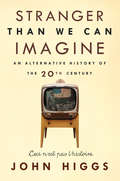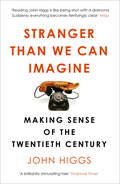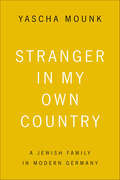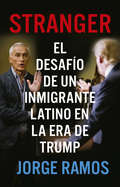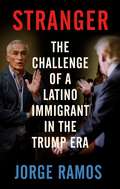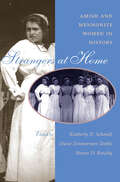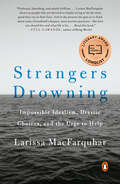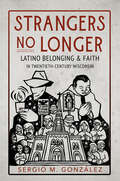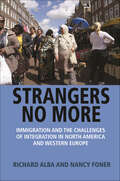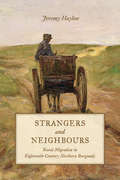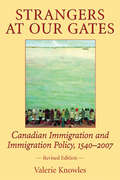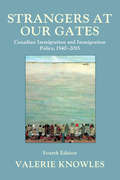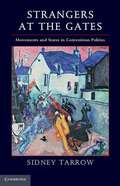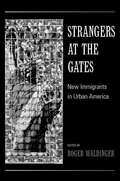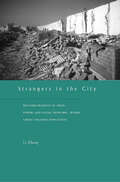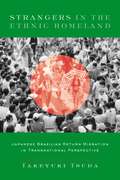- Table View
- List View
Stranger (En espanol): El Desafio De Un Inmigrante Latino En La Era De Trump
by Jorge RamosHay veces en que me siento como un extraño en el país donde he pasado más de la mitad de mi vida. No es por falta de oportunidades, ni una queja. Es, más bien, una especie de desilusión. Jamás me imaginé que después de 35 años en Estados Unidos iba a seguir siendo un stranger para muchos. Pero eso soy. Jorge Ramos, periodista galardonado con premios Emmy, reconocido presentador del Noticiero Univisión y considerado la voz de los sin voz de la comunidad latina, fue expulsado de una rueda de prensa del candidato presidencial Donald Trump en Iowa en el año 2015 tras cuestionar sus planes sobre inmigración. En este manifiesto personal, Ramos explora qué significa ser un inmigrante latino, o simplemente un inmigrante, en los Estados Unidos de nuestros días. Mediante datos y estadísticas, su olfato para encontrar historias y su propia memoria personal, Ramos nos muestra el rostro cambiante de America y explora las razones por las que él, y muchos otros millones de inmigrantes, aún se sienten como strangers en este país. Es precisamente su estilo de confrontación el que le ha ganado a Ramos la confianza de tantos hispanos. Ellos saben que en muchos países al sur de Estados Unidos las preguntas directas pueden significar, no solo perder el acceso, sino también perder la vida. --Marcela Valdes, The New York Times
Stranger Rape
by Kevin BonnycastleKevin Denys Bonnycastle's Stranger Rape is an in-depth study of the lives of fourteen men who raped women unknown to them. Using new data derived from official offender files, offender program observations, and the men's personal histories, Bonnycastle documents, compares, and contrasts their experiences from boyhood to adulthood and eventual incarceration.Bonnycastle argues that stranger-rapists do not fit existing portrayals of them as predatory monsters or misogynist everymen. Instead, through an innovative approach that builds on research and theory from feminism, gender studies, critical criminology, and masculinity studies, she positions stranger-rape as a matter of experiences of pain and powerlessness rather than of male power and control. The book's major achievement is to recognize rapists and rape in their particularity and complexity in the hope that critical thinking about their lives and about their experiences in penal contexts and programs may eventually lead to what one respondent called his 'road to redemption.'Please note that this book includes graphic content.
Stranger Than We Can Imagine: An Alternative History of the 20th Century
by John HiggsIn Stranger Than We Can Imagine, John Higgs argues that before 1900, history seemed to make sense. We can understand innovations like electricity, agriculture and democracy. The twentieth century, in contrast, gave us relativity, cubism, quantum mechanics, the id, existentialism, Stalin, psychedelics, chaos mathematics, climate change and postmodernism. In order to understand such a disorienting barrage of unfamiliar and knotty ideas, Higgs shows us, we need to shift the framework of our interpretation and view these concepts within the context of a new kind of historical narrative. Instead of looking at it as another step forward in a stable path, we need to look at the twentieth century as a chaotic seismic shift, upending all linear narratives.Higgs invites us along as he journeys across a century "about which we know too much" in order to grant us a new perspective on it. He brings a refreshingly non-academic, eclectic and infectiously energetic approach to his subjects as well as a unique ability to explain how complex ideas connect and intersect-whether he's discussing Einstein's theories of relativity, the Beat poets' interest in Eastern thought or the bright spots and pitfalls of the American Dream.
Stranger Than We Can Imagine: Making Sense of the Twentieth Century
by John Higgs'An illuminating work of massive insight' Alan Moore'A sensational book. Heartily recommended' Rufus HoundIt is the century about which we know too much, yet understand too little. With disorientating ideas such as relativity, cubism, the id, existentialism, chaos mathematics and postmodernism to contend with, the twentieth century, John Higgs argues, cannot fit easily into a traditional historical narrative. Time, then, for a new perspective. Higgs takes us on a refreshingly eclectic journey through the knotty history of the strangest of centuries. In the company of radical artists, scientists, geniuses and eccentrics, he shows us how the elegant, clockwork universe of the Victorians became increasingly woozy and uncertain; and how in the twentieth century we discovered that our world is not just stranger than we imagine, but 'stranger than we can imagine'.
Stranger in My Own Country: A Jewish Family in Modern Germany
by Yascha MounkA moving and unsettling exploration of a young man's formative years in a country still struggling with its pastAs a Jew in postwar Germany, Yascha Mounk felt like a foreigner in his own country. When he mentioned that he is Jewish, some made anti-Semitic jokes or talked about the superiority of the Aryan race. Others, sincerely hoping to atone for the country's past, fawned over him with a forced friendliness he found just as alienating. Vivid and fascinating, Stranger in My Own Country traces the contours of Jewish life in a country still struggling with the legacy of the Third Reich and portrays those who, inevitably, continue to live in its shadow. Marshaling an extraordinary range of material into a lively narrative, Mounk surveys his countrymen's responses to "the Jewish question." Examining history, the story of his family, and his own childhood, he shows that anti-Semitism and far-right extremism have long coexisted with self-conscious philo-Semitism in postwar Germany. But of late a new kind of resentment against Jews has come out in the open. Unnoticed by much of the outside world, the desire for a "finish line" that would spell a definitive end to the country's obsession with the past is feeding an emphasis on German victimhood. Mounk shows how, from the government's pursuit of a less "apologetic" foreign policy to the way the country's idea of the Volk makes life difficult for its immigrant communities, a troubled nationalism is shaping Germany's future.
Stranger in the Village of the Sick: A Memoir of Cancer, Sorcery, and Healing
by Paul StollerStranger in the Village of the Sick follows Stoller down this unexpected path toward personal discovery, growth, and healing. The stories here are about life in the village of the healthy and the village of the sick, and they highlight differences in how illness is culturally perceived.
Stranger: El desafío de un inmigrante latino en la era de Trump
by Jorge Ramos<P>Jorge Ramos, periodista mexicano-estadounidense galardonado con premios Emmy, reconocido presentador del Noticiero Univisión y considerado "la voz de los sin voz" de la comunidad latina, fue expulsado de una rueda de prensa del candidato presidencial Donald Trump en Iowa en el año 2015 tras cuestionar sus planes sobre inmigración. <P>En este manifiesto personal, Ramos explora qué significa ser un inmigrante latino, o simplemente un inmigrante, en los Estados Unidos de nuestros días. <P>Mediante datos y estadísticas, su olfato para encontrar historias y su propia memoria personal, Ramos nos muestra el rostro cambiante de América y explora las razones por las que él, y muchos otros millones de inmigrantes, aún se sienten como strangers en este país.
Stranger: The Challenge of a Latino Immigrant in the Trump Era
by Jorge Ramos“There are times when I feel like a stranger in this country. I am not complaining and it’s not for lack of opportunity. But it is something of a disappointment. I never would have imagined that after having spent thirty five years in the United States I would still be a stranger to so many. But that’s how it is”. Jorge Ramos, an Emmy award-winning journalist, Univision’s longtime anchorman and widely considered the “voice of the voiceless” within the Latino community, was forcefully removed from an Iowa press conference in 2015 by then-candidate Donald Trump after trying to ask about his plans on immigration. In this personal manifesto, Ramos sets out to examine what it means to be a Latino immigrant, or just an immigrant, in present-day America. Using current research and statistics, with a journalist’s nose for a story, and interweaving his own personal experience, Ramos shows us the changing face of America while also trying to find an explanation for why he, and millions of others, still feel like strangers in this country. “It is precisely this pattern of confrontation… that has won Ramos the trust of so many Hispanics. They know that in many countries south of the United States, direct questions can provoke not simply a loss of access but also a loss of life.” --Marcela Valdes, The New York Times
Strangers At Home: Amish and Mennonite Women in History (Center Books In Anabaptist Studies)
by Kimberly D. Schmidt Diane Zimmerman Umble Steven D. Reschly“Uniformly sophisticated, interesting, and worthwhile” essays focusing on the often misunderstood experiences of Anabaptist women across 400 years (Agricultural History).Equal parts sociology, religious history, and gender studies, this book explores the changing roles and issues surrounding Anabaptist women in communities ranging from sixteenth-century Europe to contemporary North America. Gathered under the overarching theme of the insider/outsider distinction, the essays discuss, among other topics:• How womanhood was defined in early Anabaptist societies of the sixteenth and seventeenth centuries, and how women served as central figures by convening meetings across class boundaries or becoming religious leaders • How nineteenth-century Amish tightened the connections among the individual, the family, the household, and the community by linking them into a shared framework with the father figure at the helm • The changing work world and domestic life of Mennonite women in the three decades following World War II • The recent ascendency of antimodernism and plain dress among the Amish • The special difficulties faced by scholars who try to apply a historical or sociological method to the very same cultural subgroups from which they derive. The essays in this collection follow a fascinating journey through time and place to give voice to women who are often characterized as the “quiet in the land.” Their voices and their experiences demonstrate the power of religion to shape identity and social practice.“Makes a major contribution to our understanding of Anabaptist history and the ongoing construction of Anabaptist identity.” —Mennonite Quarterly Review“This work is significant both for its breadth . . . and for offering glimpses into the varieties of Mennonite and Amish life.” —Annals of Iowa
Strangers Drowning: Grappling with Impossible Idealism, Drastic Choices, and the Overpowering Urge to Help
by Larissa MacfarquharWhat does it mean to devote yourself wholly to helping others? In Strangers Drowning, Larissa MacFarquhar seeks out people living lives of extreme ethical commitment and tells their deeply intimate stories; their stubborn integrity and their compromises; their bravery and their recklessness; their joys and defeats and wrenching dilemmas. A couple adopts two children in distress. But then they think: If they can change two lives, why not four? Or ten? They adopt twenty. But how do they weigh the needs of unknown children in distress against the needs of the children they already have? Another couple founds a leprosy colony in the wilderness in India, living in huts with no walls, knowing that their two small children may contract leprosy or be eaten by panthers. The children survive. But what if they hadn't? How would their parents' risk have been judged? A woman believes that if she spends money on herself, rather than donate it to buy life-saving medicine, then she's responsible for the deaths that result. She lives on a fraction of her income, but wonders: when is compromise self-indulgence and when is it essential? We honor such generosity and high ideals; but when we call people do-gooders there is skepticism in it, even hostility. Why do moral people make us uneasy? Between her stories, MacFarquhar threads a lively history of the literature, philosophy, social science, and self-help that have contributed to a deep suspicion of do-gooders in Western culture. Through its sympathetic and beautifully vivid storytelling, Strangers Drowning confronts us with fundamental questions about what it means to be human. In a world of strangers drowning in need, how much should we help, and how much can we help? Is it right to care for strangers even at the expense of those we are closest to? Moving and provocative, Strangers Drowning challenges us to think about what we value most, and why.From the Hardcover edition.
Strangers No Longer: Latino Belonging and Faith in Twentieth-Century Wisconsin (Latinos in Chicago and Midwest)
by Sergio M. GonzálezHospitality practices grounded in religious belief have long exercised a profound influence on Wisconsin’s Latino communities. Sergio M. González examines the power relations at work behind the types of hospitality--welcoming and otherwise--practiced on newcomers in both Milwaukee and rural areas of the Badger State. González’s analysis addresses central issues like the foundational role played by religion and sacred spaces in shaping experiences and facilitating collaboration among disparate Latino groups and across ethnic lines; the connections between sacred spaces and the moral justification for social justice movements; and the ways sacred spaces evolved into places for mitigating prejudice and social alienation, providing sanctuary from nativism and repression, and fostering local and transnational community building. Perceptive and original, Strangers No Longer reframes the history of Latinos in Wisconsin by revealing religion’s central role in the settlement experience of immigrants, migrants, and refugees.
Strangers No More: Immigration and the Challenges of Integration in North America and Western Europe
by Nancy Foner Richard AlbaAn up-to-date and comparative look at immigration in Europe, the United States, and CanadaStrangers No More is the first book to compare immigrant integration across key Western countries. Focusing on low-status newcomers and their children, it examines how they are making their way in four critical European countries—France, Germany, Great Britain, and the Netherlands—and, across the Atlantic, in the United States and Canada. This systematic, data-rich comparison reveals their progress and the barriers they face in an array of institutions—from labor markets and neighborhoods to educational and political systems—and considers the controversial questions of religion, race, identity, and intermarriage.Richard Alba and Nancy Foner shed new light on questions at the heart of concerns about immigration. They analyze why immigrant religion is a more significant divide in Western Europe than in the United States, where race is a more severe obstacle. They look at why, despite fears in Europe about the rise of immigrant ghettoes, residential segregation is much less of a problem for immigrant minorities there than in the United States. They explore why everywhere, growing economic inequality and the proliferation of precarious, low-wage jobs pose dilemmas for the second generation. They also evaluate perspectives often proposed to explain the success of immigrant integration in certain countries, including nationally specific models, the political economy, and the histories of Canada and the United States as settler societies.Strangers No More delves into issues of pivotal importance for the present and future of Western societies, where immigrants and their children form ever-larger shares of the population.
Strangers and Neighbors
by Andrea M. VoyerThe city of Lewiston, Maine, has struggled since its mills began closing in the 1950s. In the new millennium Lewiston acquired a new identity as 'Maine's Mogadishu'. Beginning in 2001, substantial Somali immigrant settlement gave Lewiston the largest per capita Somali population in the United States and sparked controversies and collaborations that redefined the city. In Strangers and Neighbors, Andrea M. Voyer shares five years of observations in the city of Lewiston. She shows how long-time city residents and immigrant newcomers worked to develop an understanding of the inclusive and caring community in which they could all take part. Yet the sense of community developed in Lewiston was built on the appreciation of diversity in the abstract rather than by fostering close and caring relationships across the boundaries of class, race, culture, and religion. Through her sensitive depictions of the experiences of Somalis, Lewiston city leadership, anti-racism activists, and even racists, Voyer reveals both the promise of and the obstacles to achieving community in the face of diversity.
Strangers and Neighbours
by Jeremy HayhoeThough historians have come to acknowledge the mobility of rural populations in early modern Europe, few books demonstrate the intensity and importance of short-distance migrations as definitively as Strangers and Neighbours. Marshalling an incredible range of evidence that includes judicial records, tax records, parish registers, and the census of 1796, Jeremy Hayhoe reconstructs the migration profiles of more than 70,000 individuals from eighteenth-century northern Burgundy.In this book, Hayhoe paints a picture of a surprisingly mobile and dynamic rural population. More than three quarters of villagers would move at least once in their lifetime; most of those who moved would do so more than once, in many cases staying only briefly in each community. Combining statistical analysis with an extensive discussion of witness depositions, he brings the experiences and motivations of these many migrants to life, creating a virtuoso reconceptualization of the rural demography of the ancien régime.
Strangers at Home: Amish and Mennonite Women in History (Center Books in Anabaptist Studies)
by Kimberly D. Schmidt Diane Zimmerman Umble Steven D. ReschlyThis collection of original essays focuses on the rich, historically diverse, and often misunderstood experiences of Amish, Mennonite, and other women of Anabaptist traditions across 400 years. Equal parts sociology, religious history, and gender studies, the book explores the changing roles and issues surrounding Anabaptist women in communities ranging from sixteenth-century Europe to contemporary North America. Gathered under the overarching theme of the insider/outsider distinction, the essays discuss, among other topics: •How womanhood was defined in early Anabaptist societies of the sixteenth and seventeenth centuries, and how women served as central figures by convening meetings across class boundaries or becoming religious leaders •How nineteenth-century Amish tightened the connections among the individual, the family, the household, and the community by linking them into a shared framework with the father figure at the helm •The changing work world and domestic life of Mennonite women in the three decades following World War II •The recent ascendency of antimodernism and plain dress among the Amish •The special difficulties faced by scholars who try to apply a historical or sociological method to the very same cultural subgroups from which they derive The essays in this collection follow a fascinating journey through time and place to give voice to women who are often characterized as the "quiet in the land." Their voices and their experiences demonstrate the power of religion to shape identity and social practice.
Strangers at Our Gates: Canadian Immigration and Immigration Policy, 1540-2006 Revised Edition
by Valerie KnowlesImmigrants and immigration have always been central to Canadians’ perception of themselves as a country and as a society. In this crisply written history, Valerie Knowles describes the different kinds of immigrants who have settled in Canada, and the immigration policies that have helped to define the character of Canadian immigrants over the centuries. Key policymakers and moulders of public opinion figure prominently in this colourful story, as does the role played by racism. This new and revised edition contains additional material on immigration to Newfoundland and Nova Scotia, sections on the evacuee children of the Second World War and Canadian War Brides, and material relating to significant developments in the immigration and refugee field since 1996. Special attention is paid to the Immigration and Refugee Protection Act of 2001.
Strangers at Our Gates: Canadian Immigration and Immigration Policy, 1540–2015
by Valerie KnowlesIn this new and revised edition, Knowles explores new materials relating to multiculturalism and immigration. Immigrants and immigration have always been central to Canadians’ perception of themselves as a country and a society. In this crisply written history, Valerie Knowles describes the different kinds of immigrants who have settled in Canada, and the immigration policies that have helped define the character of Canadian immigrants over the centuries. Key policymakers and shapers of public opinion figure prominently in this colourful story, as does the role played by racism. This new and revised edition features a chapter on the Conservative government’s handling of immigration between 2006 and 2014. Special attention is paid to the role played by the activist minister Jason Kenney and his attempts to develop a faster, more flexible immigration regime. The Temporary Foreign Worker Program and the Interim Federal Health Program are also discussed. The book’s final chapter, “Issues in the Twenty-First Century,” introduces new material relating to multiculturalism and outlines arguments supporting population growth, increased immigration, and decreased immigration.
Strangers at the Gates: Movements and States in Contentious Politics
by Sidney TarrowPlaces social movements in the broader arena of contentious politics in relation to states, political parties and other actors.
Strangers at the Gates: New Immigrants in Urban America
by Roger David WaldingerStrangers at the Gates looks at the connection between urban fates and immigrant destinies, asking about the prospects for progress in the capitals of immigrant America, and inquiring into the conditions that will hinder or aid the newest Americans in their quest to get ahead.
Strangers from a Different Shore: A History of Asian Americans
by Ronald T. TakakiPresents a sweeping overview on the history of Asian Americans, from their first arrival to the present generations.
Strangers in Blood
by Jean E. FeerickStrangers in Blood explores, in a range of early modern literature, the association between migration to foreign lands and the moral and physical degeneration of individuals. Arguing that, in early modern discourse, the concept of race was primarily linked with notions of bloodline, lineage, and genealogy rather than with skin colour and ethnicity, Jean E. Feerick establishes that the characterization of settler communities as subject to degenerative decline constituted a massive challenge to the fixed system of blood that had hitherto underpinned the English social hierarchy.Considering contexts as diverse as Ireland, Virginia, and the West Indies, Strangers in Blood tracks the widespread cultural concern that moving out of England would adversely affect the temper and complexion of the displaced individual, changes that could be fought only through willed acts of self-discipline. In emphasizing the decline of blood as found at the centre of colonial narratives, Feerick illustrates the unwitting disassembling of one racial system and the creation of another.
Strangers in Our Midst
by Elise ChenierContemporary efforts to treat sex offenders are rooted in the post-Second World War era, in which an unshakable faith in science convinced many Canadian parents that pedophilia could be cured. Strangers in Our Midst explores the popularization of the notion of sexual deviancy as a way of understanding sexual behaviour, the emergence in Canada of legislation directed at sex offenders, and the evolution of treatment programs in Ontario.Popular discourses regarding sexual deviancy, legislative action against sex criminals, and the implementation of treatment programs for sex offenders have been widely attributed to a reactionary, conservative moral panic over changing sex and gender roles after the Second World War. Elise Chenier challenges this assumption, arguing that, in Canada, advocates of sex-offender treatment were actually liberal progressives. Drawing on previously unexamined sources, including medical reports, government commissions, prison files, and interviews with key figures, Strangers in Our Midst offers an original critical analysis of the rise of sexological thinking in Canada, and shows how what was conceived as a humane alternative to traditional punishment could be put into practice in inhumane ways.
Strangers in Our Midst: The Political Philosophy of Immigration
by David MillerHow should democracies respond to the millions who want to settle in their societies? David Miller's analysis reframes immigration as a question of political philosophy. Acknowledging the impact on host countries, he defends the right of states to control their borders and decide the future size, shape, and cultural make-up of their populations.
Strangers in the City: Reconfigurations of Space, Power, and Social Networks Within China’s Floating Population
by Li ZhangWith rapid commercialization, a booming urban economy, and the relaxation of state migration policies, over 100 million peasants, known as China's "floating population," have streamed into large cities seeking employment and a better life. This massive flow of rural migrants directly challenges Chinese socialist modes of state control. This book traces the profound transformations of space, power relations, and social networks within a mobile population that has broken through the constraints of the government's household registration system. The author explores this important social change through a detailed ethnographic account of the construction, destruction, and eventual reconstruction of the largest migrant community in Beijing. She focuses on the informal privatization of space and power in this community through analyzing the ways migrant leaders build their power base by controlling housing and market spaces and mobilizing social networks. The author argues that to gain a deeper understanding of recent Chinese social and political transformations, one must examine not only to what extent state power still dominates everyday social life, but also how the aims and methods of late socialist governance change under new social and economic conditions. In revealing the complexities and uncertainties of the shifting power and social relations in post-Mao China, this book challenges the common notion that sees recent changes as an inevitable move toward liberal capitalism and democracy.
Strangers in the Ethnic Homeland: Japanese Brazilian Return Migration in Transnational Perspective
by Takeyuki TsudaSince the late 1980s, Brazilians of Japanese descent have been "return" migrating to Japan as unskilled foreign workers. With an immigrant population currently estimated at roughly 280,000, Japanese Brazilians are now the second largest group of foreigners in Japan. Although they are of Japanese descent, most were born in Brazil and are culturally Brazilian. As a result, they have become Japan's newest ethnic minority.Drawing upon close to two years of multisite fieldwork in Brazil and Japan, Takeyuki Tsuda has written a comprehensive ethnography that examines the ethnic experiences and reactions of both Japanese Brazilian immigrants and their native Japanese hosts. In response to their socioeconomic marginalization in their ethnic homeland, Japanese Brazilians have strengthened their Brazilian nationalist sentiments despite becoming members of an increasingly well-integrated transnational migrant community. Although such migrant nationalism enables them to resist assimilationist Japanese cultural pressures, its challenge to Japanese ethnic attitudes and ethnonational identity remains inherently contradictory. Strangers in the Ethnic Homeland illuminates how cultural encounters caused by transnational migration can reinforce local ethnic identities and nationalist discourses.


